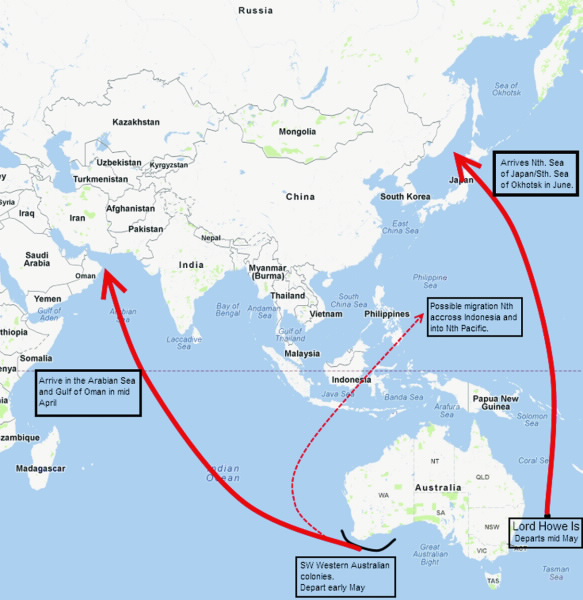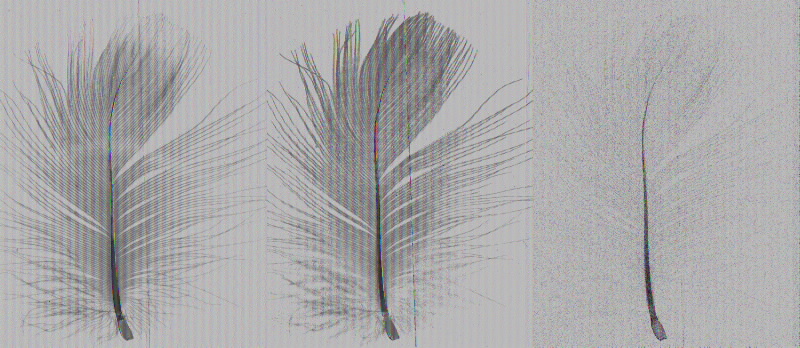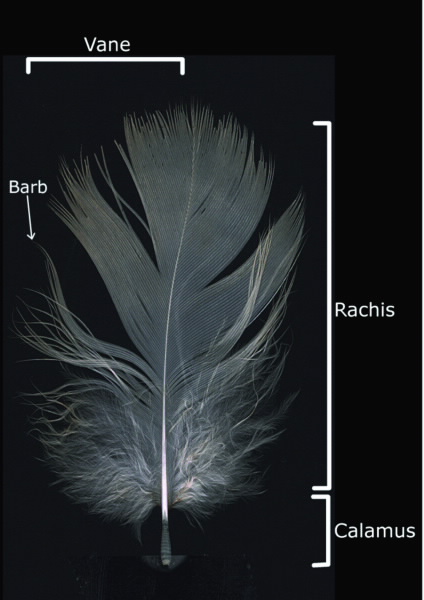Increased trace metal concentrations in feathers from migratory birds are regularly used in ecotoxicology as indicators of individual, population and environmental health. For most routine sampling and analysis, usually only parts of feathers are sampled.
Sampling procedures have major short-comings because they ignore variations in feather development and how the contaminant enters the bird’s cells during feather growth.
In order to gain a better understanding of contaminant distribution along the full length of a feather, ANSTO used the X-ray fluorescent microprobe at the Australian Synchrotron to obtain high resolution elemental images of breast feathers collected from chicks of Flesh-footed Shearwater (Puffinus carneipes) also known locally as Mutton Birds.
The study revealed, with exceptional clarity, previously unknown distribution patterns of trace metals necessary for healthy development as well as showing how the birds absorb metals that come from major pollutants such as micro-plastics, disintegrating plastic waste that is increasingly affecting a wide range of marine animals including sea birds.
 |
| Fig 1. Flesh-footed Shearwater (Puffinus Carnepes). Documented and proposed migratory patterns of some breeding colonies of Flesh-footed Shearwater off Lord Howe Island and south-west W.A |
The Flesh-footed Shearwater
The Flesh-footed Shearwater is a trans-equatorial migrant seabird that is a common local visitor to the waters of the continental shelf and slope of south-west Australia and around Lord Howe Island, which both serve as breeding and foraging grounds [1].
The Fleshfooted Shearwater is listed under the Japan-Australia Migratory Bird Agreement (JAMBA) and is categorised as ‘vulnerable’ by the Threatened Species Conservation Act (1995) in NSW, ‘rare’ in South Australia and ‘in decline’ in New Zealand.
Surveys of populations only go back ~40 years but decline is evident through more recent work [1]. Flesh-footed Shearwaters generally pair for life and will return to the same burrow every year to breed from September to May. Upon completion of the breeding season, birds from Western Australian colonies migrate north across the Indian ocean to the Arabian Sea and the Gulf of Oman while birds from Lord Howe Island and New Zealand move north across the Pacific Ocean to the Sea of Japan and southern Sea of Okhotsk (Fig.1,2) [1].
Due to their global distribution and reliance on marine resources, sea birds function as indicators of marine environmental contamination. Ecotoxicology often uses feather chemistry and composition to infer information about the individual, population and environment of the bird during the period of feather growth [2-6]. As most feathers are replaced yearly, they contain valuable indicators of the state of the bird and its environment over this period, which can be days to weeks [4].
The distinct yet consistent migratory patterns of the Flesh-footed Shearwater allow avian chemoecological methods to be used to gain complementary data from distinct locations across the globe. Flesh-footed Shearwater breast feathers are replaced on the wintering grounds in the southern hemisphere [7].
The breast feathers that were used in this experiment were collected from the Lord Howe Island colonies. These samples contain information regarding the overall health of the bird during the breeding season when the birds are foraging within the Tasman Sea.
Marine birds and micro-plastics
During migration, birds pick up plastics floating on the ocean surface. Decaying plastics have become a globally widespread and abundant marine environmental contaminant [7,8] and a major source of persistent organic pollutants and heavy metals.
These bio-accumulate particularly through the course of feeding of the birds’ offspring [3]. The ingestion of plastic by marine birds has been well-documented [8], particularly in Flesh-footed Shearwaters, often leading to gastrointestinal blockage and death [3].
While larger pieces of plastic are mostly a mechanical hazard for the ingesting bird, microplastics are particles of synthetic organic polymers <5mm in size; typically too small to cause physical damage [9]. However, while floating in the marine environment for many years or decades, plastic items act as sorbents for other contaminants, such as persistent organic pollutants and heavy metals [9].
The impact of microplastic contamination is yet to be fully realised, though it may lead to higher accumulation of persistent organic pollutants and heavy metals in marine surface feeders as the bird is likely to ingest much more over a lifetime [9].
 |
| Fig 2. The map shows the tracks of individual Flesh-footed Shearwater birds tagged with light loggers follows their migration to the Sea of Japan from Lord Howe Island. |
Elemental imaging using X-ray fluorescence microscopy
The X-ray fluorescence microscopy beamline [10] at the Australian Synchrotron (Fig.3) was used to produce high-definition elemental images (Fig. 4) of breast feathers collected from Flesh-footed Shearwater chicks on Lord Howe Island.
The scanning X-ray fluorescence microprobe used a 16 keV incident energy beam focused to several microns to create images with pixel sizes between 5-70 μm. This technique allowed us to reconstruct quantitative elemental concentration maps or images of the feathers for a wide range of elements with an atomic number greater than 19 (potassium) as well as look at patterns of distribution within regions of interest (Fig. 5). Fig. 6 indicates the anatomy of a feather.
It is a common sampling procedure, such as in stable isotope measurement, to only sub-sample the feather by cutting off the tip and using it for further analysis [2]. However, our results show intricate patterns that reflect growths pattern Fleshfooted Shearwater chicks that sub-sampling and analysis would normally miss.
A better understanding of the hitherto unknown within-sample heterogenity of the elemental distribution in individual feathers reduce the risk of over- or underestimation of population parameters.
 |
| Fig 3. Nicholas Howell and Jennifer Lavers from the University of Tasmania, used the Australian Synchrotron's XFM beamline for their research. |
Of particular interest is the distribution of elements that are known to be essential for healthy plumage growth. When reconstructing the image based on zinc (Zn) concentration, a striking regular banding pattern is observed running the length of the feather and radiating out from the calamus and rachis into the vanes (Fig. 5). This shape of the banding is consistent with the established mechanism of feather growth [11].
The distribution of Calcium is localised in high concentrations to the base of the calamus. It forms a corset-shaped structure at the calamus to skin interface but is scarce along the length of the rachis. Arsenic can be observed uniformly along the length of the rachis but is diminished in the calamus.
The most abundant element observed using this technique is Bromine (Br). Br is present in high concentrations throughout the feather structure.
It is readily concentrated from sea water by marine algae and bacteria which are then ingested by organisms feeding at the surface [12-14]. Iron (Fe) can be observed almost exclusively in the vanes of the feather and is barely detectable in the rachis. Occasional spots of iron detected on the calamus correspond to contamination from blood or tissue remaining after plucking.
 |
| Fig 4. X-ray fluroescence miroscopy images of Flesh-footed Shearwater chick breast feather showing distributions of (left to right) Bromine, Zinc, Arsenic, Calcium. |
Outlook
The challenges facing the Flesh-footed Shearwater include plastic ingestion, contamination, habitat loss, and by-catch in fisheries [1]. The species represents a convenient indicator of marine environmental health, locally and internationally, therefore further efforts made to understand challenges to its physiology are of interest from a conservation and environmental monitoring point of view.
High-resolution X-ray fluorescence microscopy allows the acquisition of so far unseen two-dimensional elemental distribution maps and highlights the significant uptake of contaminants by migratory birds.
Together with knowledge about the birds’ migratory route, elemental distribution data from individual feathers can provide new and more detailed information about the time period of up-take and thus the origin of the bioaccumulated contamination.
If the up-take pattern of a normal trace element is found to be disturbed, there may potentially also be an opportunity to develop a biomarker for any adverse health effects of pollutants. Future scope of work includes the more systematic study of species variations as well as variations in the distribution maps for normal and contaminant elements due to changes in feed intake.
 |
| Fig 5. x-ray fluroescence microscopy image showing Zn banding patterns along the length of the feather. |
Acknowledgement
We acknowledge funding from the W.V. Scott Charitable Trust and field assistance provided by Ian Hutton, Curator of the Lord Howe Island Museum.
 |
| Fig 6. Photograph of a Flesh-fooed Shearwater feather showng the calamus, rachis, vanes and barbs. |
Authors
Nicholas Howell1, Jennifer Lavers2, David Paterson3 Richard Garrett1, Richard Banati1,4
1ANSTO, 2Institute for Marine & Antarctic Studies, University of Tasmania, 3Australian Synchrotron, 4University of Sydney
References
- Department of Sustainability, E., Water, Population and Communities, Ardenna carneipes in Species Profile and Threats Database, in Species Profile and Threats Database 2012, Department of Sustainability, Environment, Water, Population and Communities.
- Bortolotti, G.R., Flaws and pitfalls in the chemical analysis of feathers: bad news-good news for avian chemoecology and toxicology. Ecological Applications, 2010. 20(6): p. 9.
- Bond, A.L. and J.L. Lavers, Trace Element Concentration in Feathers of Fleshfooted Shearwaters (Puffinus carneipes) from Across Their Breeding Range. Archives of Environmental Contamination Toxicology, 2011. 61: p. 318-326.
- Bortolotti, G.R. and J.C. Barlow, Potential use of feather chemistry as an indicator of relative growth. Wilson Bulletin, 1986. 98(4): p. 516-525.
- Bortolotti, G.R., et al., Mineral profiles of Spruse Grouse feathers show habitat affinities. Journal of Wildlife Management, 1989. 53(3): p. 811-817.
- Moreno, R., et al., Seabird feathers as monitors of the levels and persistence of heavy metal pollution after the Prestige oil spill. Environmental Pollution, 2011. 159(10): p. 2454-2460.
- Marchant, S. and P.J.H. (eds), Handbook of Australian, New Zealand and Antarctic Birds. Volume 1: Ratites to Ducks. 1990, Melbourne: Oxford University Press.
- Azzarello, M.Y., Van Vleet, E. S., Marine birds and plastic pollution Marine Ecology Progress Series, 1987. 37: p. 295-303.
- Cole, M., et al., Microplastics as contaminants in the marine environment: A review. Marine Pollution Bulletin, 2011. 62(12): p. 2588-2597.
- Paterson, D., et al., The X-ray Fluorescence Microscopy Beamline at the Australian Synchrotron. AIP Conference Proceedings, 2011. 1365(1): p. 219-222.
- Prum, R.O., Development and evolutionary origin of feathers. Journal of Experimental Zoology, 1999. 285(4): p. 291-306.
- Moore, M.R., et al., Trace organic compounds in the marine environment. Marine Pollution Bulletin, 2002. 45(1–12): p. 62-68.
- Saenko, G.N., et al., Concentration of lodine and bromine by plants in the seas of Japan and Okhotsk. Marine Biology, 1978. 47(3): p. 243-250.
- Wan, Y., et al., Contribution of Synthetic and Naturally Occurring Organobromine Compounds to Bromine Mass in Marine Organisms. Environmental Science & Technology, 2010. 44(16): p. 6068-6073.


